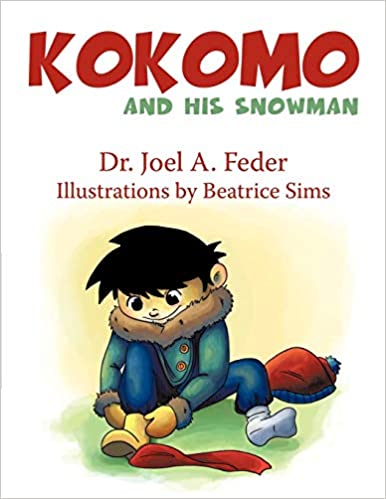Title: Kokomo and his Snowman
Author: Dr. Joel Feder
Illustrator: Beatrice Sims
Publisher: AuthorHouse
ISBN: 978-1-4520-8142-7
Genre: Illustrated Children’s Book
Pages: 32
Reviewed by: Beth Adams
Pacific Book Review
Author Dr. Joel Feder, along with his illustrator Beatrice Sims, has created a beautiful children’s story in his book Kokomo and his Snowman.
One morning, while this handsome and energetic 5-year-old boy Kokomo is having his oatmeal breakfast, he and his mother see how much snow had fallen during the night, and asks his mother if he could go out and build a snowman. Sure, she says. So, he puts on his boots, scarf, gloves, jacket and hat, and runs outside to play in the snow. Kokomo rolls up 3 snowballs; one large, one medium and one small, places them on top of each other and realizes he needs a carrot for the nose. He goes inside and gets a carrot from his mother, puts back on his warm clothing, and goes outside to place the carrot as the nose for his snowman. Then realizes, he needs eyes for his snowman. He goes inside and his mom gives him 3 cookies (two for the eyes and one for Kokomo to eat) and once again he dawns his snow-gear, runs outside and puts the eyes on his snowman. Next, he realizes the snowman needs a mouth; then he needs buttons; and then he needs a hat. At each time Kokomo takes off – then puts back on – his boots, gloves, jacket, scarf and hat. The repetitiveness of this routine has a way to “drill into the minds” of the children being read the story a sequence of events necessary to perform as a prerequisite for going outside. Plus, Kokomo realizing, after he completes one task, the next item needed shows a problem-solving method of achieving one goal at a time, in order to complete a larger task. These lessons, a bit subliminal within the story, do provide a very educational pattern of problem solving for young minds – after all, as easy and natural as it may seem for adults, children have to learn the foundation of problem solving.
This makes Kokomo and his Snowman an educational resource, albeit disguised as a fun children’s story. I highly recommend this book to be a part of all children’s libraries, as the more times they read (or are read too) the story, the more aware of problem solving they will become.


